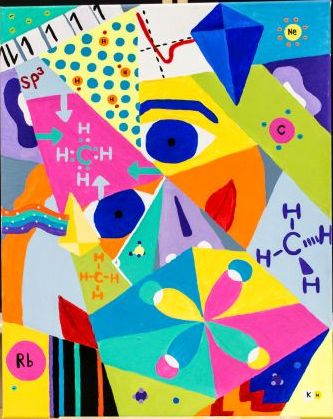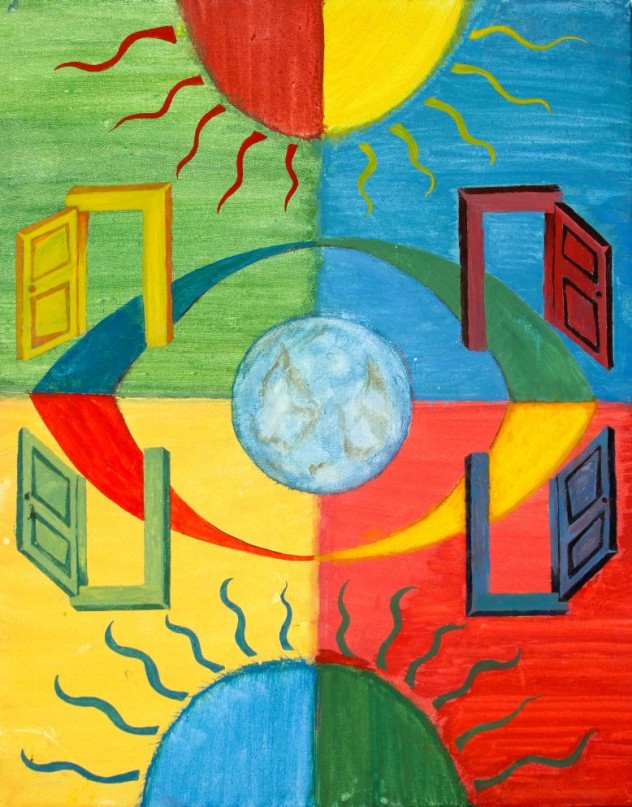(Featured Artwork: “Quantum”)
(Chemistry Department, Vanier College, Montreal, QC, Canada)
Instructional strategies that are based on lecture, drill, and practice are commonly employed in traditional Chemistry courses to help students memorize collections of facts and procedures of increasing complexity. These strategies emphasize the acquisition of knowledge through the development of logical-mathematical skills employed in problem solving and verbal-linguistic abilities to make sense of the concepts and jargon in the field.
Unfortunately, imagination is often neglected.
Chemistry is highly abstract and deals with apparently inconsistent multiple representations, such as the wave-particle duality and the various atomic models. Although it is customary to teach chemistry as if its ultimate goal were finding reasonable solutions to practical problems, a coherent and sophisticated conceptual understanding requires the learner to reflect on the role of mental models. Imagination can help.
Starting in their first science courses, students need to develop their visual-spatial skills as a means of gradually acquiring visual literacy while, at the same time, grappling with the symbols and conventions displayed in the figures, diagrams, and charts that are used in the textbook. Since questioning the legitimacy of mental models is required in rigorous scientific research, it is crucial to instil in students, especially in their early stages of schooling, the idea that there are intrinsic limitations in any scientific model.
(Artwork: “Doors Of Perception”)
The Art & Science Project: Details
(To learn more about the Art & Science project, visit the website www.artandchemistry.ca)
In 2009, the Art & Science Project started at Vanier College as part of the course on the History of Science in the Liberal Arts program and was later adapted to three core Chemistry courses (General, Solution, and Organic Chemistry) in the Science program. The project uses a cross-disciplinary integration between visual arts and the natural sciences to promote a deeper understanding of the important role of models. The Liberal Arts students analyze the parallels between the evolution of modern scientific concepts and the art movements from the same historical periods. The goal is to portray these concepts using visual arts as means of creating meaning through symbolic visual representations while developing new perceptions of visual forms.
Science students select a theme of interest in Chemistry and create a visual representation of it that portrays some the nine big ideas in field. Big ideas are the core concepts of a subject. They are the most important takeaways from a course, and they need to be uncovered to help students construct their knowledge more effectively. In Chemistry, big ideas revolve around, for example, “why do atoms bond?” and “why do reactions take place?” among others. These big ideas are broad, abstract, and nonobvious. Quite often, they are even counterintuitive to novices.
(Artwork: “Consciousness of an Atom”) 
Peter Atkins outlined nine big ideas in Chemistry, namely, the atomic nature of matter, chemical bond, periodic properties, molecular shape, intermolecular forces, types of chemical reactions, energy conservation, entropy, and barriers to reactions. By exploring these “big ideas” and the ways they interconnect, students can acquire deeper conceptual change by crossing threshold concepts which are transformative, integrated, irreversible, and troublesome concepts that expand the disciplinary boundaries and the ways of thinking in a discipline.
Over the course of six weeks, each student creates a draft using an online document outside the classroom and participates in asynchronous dialogues through which he or she develops ideas and receives feedback from science and art teachers. Students present their finished artwork to their classmates, write a self-reflective journal, and conduct a self-evaluation based on a rubric that is provided. This endeavor nurtures their personal and academic growth through questioning, play, and self-reflection. Students have the final word on the themes they choose and the artistic choices they make. This freedom reinforces a sense of ownership and the value of actively constructing knowledge by connecting the artwork with their own lives, passions, and interests. Based on such a personal outlook, this activity has the potential to cognitively engage students at higher levels of abstraction by enhancing their engagement and their ability to transfer knowledge across disciplines in school, as well as from school to both home and the workplace.
(Artwork: “Space and Time”)
Project work challenges the common misconception that scientific knowledge is fixed and universal and forces students to take on a more active role in their learning process. As a result, their creativity and imagination are stimulated and rewarded on a personal level. Learning occurs through a process of discovery that is mediated by social interactions between peers and teachers in a stimulating environment.
Concluding Thoughts
Since images can engage students in ways that words and formulas cannot, it is important to include artistic expression in the science curriculum all the way from K-12 to graduate school. Enhancing the quality of instruction by providing more interactive, engaging, and rewarding lessons is pivotal to achieving a meaningful and successful learning experience. The success of this approach has the potential to boost student interest in science as well as increase the number of students pursuing science careers.
More information about the history and theoretical foundations of the project can be found in the following article (available online):
Lima, J. (2016). The Art & Science Project: Constructing knowledge through creative assessments. Learning Landscapes, 9(2), 399-416. Retrieved from http://www.learninglandscapes.ca/images/documents/ll-no18/lima.pdf
(Artwork: “POPcasso”)

Don’t miss a thing. Subscribe to imaginED now and get a weekly email to your inbox with all our cross-curricular imagination-focused lessons, units, discussion topics and more.





Wow – this is such a cool idea! I love how this could engage the imagination to engage more deeply in the scientific content.
Hi Aubrey–Agreed. There is so much potential for learning with this kind of activity. 🙂
SO Amazing.
Brilliant. Chemistry requires a robust, 3-dimensional image-generating mind. This blend of disciples facilitates that.
Hey Judy! thanks for commenting–I thought you might like this one 🙂